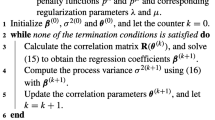Abstract
Cokriging is a variable-fidelity surrogate modeling technique which emulates a target process based on the spatial correlation of sampled data of different levels of fidelity. In this work, we address two theoretical questions associated with the so-called new Cokriging method for variable-fidelity modeling:
-
(1)
A mandatory requirement for the well-posedness of the Cokriging emulator is the positive definiteness of the associated Cokriging correlation matrix. Spatial correlations are usually modeled by positive definite correlation kernels, which are guaranteed to yield positive definite correlation matrices for mutually distinct sample points. However, in applications, low-fidelity information is often available at high-fidelity sample points and the Cokriging predictor may benefit from the additional information provided by such an inclusive sampling. We investigate the positive definiteness of the Cokriging covariance matrix in both of the aforementioned cases and derive sufficient conditions for the well-posedness of the Cokriging predictor.
-
(2)
The approximation quality of the Cokriging predictor is highly dependent on a number of model- and hyper-parameters. These parameters are determined by the method of maximum likelihood estimation. For standard Kriging, closed-form optima of the model parameters along hyper-parameter profile lines are known. Yet, these do not readily transfer to the setting of Cokriging, since additional parameters arise, which exhibit a mutual dependence. In previous work, this obstacle was tackled via a numerical optimization. Here, we derive closed-form optima for all Cokriging model parameters along hyper-parameter profile lines. The findings are illustrated by numerical experiments.
Similar content being viewed by others
References
Blazek, J.: Computational Fluid Dynamics: Principles and Applications, 1St Edn. Elsevier, Amsterdam (2001)
Courrier, N., Boucard, P.A., Soulier, B.: Variable-fidelity modeling of structural analysis of assemblies. J. Glob. Optim. 64(3), 577–613 (2016). https://doi.org/10.1007/s10898-015-0345-9
Fernández-Godino, M.G., Park, C., Kim, N.H., Haftka, R.T.: Review of multi-fidelity models. arXiv:1609.07196v3, 1–46 (2017)
Forrester, A., Sóbester, A., Keane, A.: Engineering Design Via Surrogate Modelling: A Practical Guide. Wiley, Hoboken (2008)
Forrester, A.I., Bressloff, N.W., Keane, A.J.: Optimization using surrogate models and partially converged computational fluid dynamics simulations. Proceedings of the Royal Society A: Mathematical. Phys. Eng. Sci. 462(2071), 2177–2204 (2006). https://doi.org/10.1098/rspa.2006.1679
Gallier, J.: Geometric Methods and Applications, vol. 38. Springer, New York (2011). https://doi.org/10.1007/978-1-4419-9961-0
Han, Z.H., Görtz, S.: Hierarchical kriging model for variable-fidelity surrogate modeling. AIAA J. 50(9), 1885–1896 (2012). https://doi.org/10.2514/1.J051354
Han, Z.H., Görtz, S., Zimmermann, R.: Improving variable-fidelity surrogate modeling via gradient-enhanced kriging and a generalized hybrid bridge function. Aerosp. Sci. Technol. 25(1), 177–189 (2013). https://doi.org/10.1016/j.ast.2012.01.006
Han, Z.H., Zimmermann, Görtz, S.: Alternative cokriging model for variable-fidelity surrogate modeling. AIAA J. 50(5), 1205–1210 (2012). https://doi.org/10.2514/1.J051243
Han, Z.H., Zimmermann, R., Goretz, S.: A New Cokriging Method for Variable-Fidelity Surrogate Modeling of Aerodynamic Data. In: 48Th AIAA Aerospace Sciences Meeting including the New Horizons Forum and Aerospace Exposition, Aerospace Sciences Meetings. American Institute of Aeronautics and Astronautics (2010). https://doi.org/10.2514/6.2010-1225
Journel, A.G., Huijbregts, C.J.: Mining Geostatistics. Academic Press, London (1978)
Kennedy, M.C., O’Hagan, A.: Predicting the output from a complex computer code when fast approximations are available. Biometrika 87(1), 1–13 (2000)
Koehler, J.R., Owen, A.B.: Computer experiments. In: Ghosh, S., Rao, C.R. (eds.) Design and Analysis of Experiments, Handbook of Statistics, vol. 13, pp. 261–308. Elsevier, Amsterdam (1996)
Krige, D.: A statistical approach to some basic mine valuation problems on the witwatersrand. J Chemical, Metallurgical Mining Eng Soc South Africa 52(6), 119–139 (1951)
Lophaven, S., Nielsen, H.B., Søndergaard, J.: Dace - a MATLAB Kriging Toolbox, Version 2.0S. Technical Report IMM-TR-2002-12, Technical University of Denmark, Lyngby, Denmark (2002)
Matheron, G.: Principles of geostatistics. Econ. Geol. 58, 1246–1266 (1963)
Myers, D.E.: Kriging, cokriging, radial basis functions and the role of positive definiteness. Comput. Math. Appl. 24(12), 139–148 (1992). https://doi.org/10.1016/0898-1221(92)90176-I
OpenCFD Ltd (ESI Group): OpenFOAM—the open source cfd toolbox. http://www.openfoam.com. Accessed December 5 2016 (2016)
Panik, M.: Regression Modeling: Methods, Theory, and Computation with SAS. CRC Press, Boca Raton (2009). https://books.google.dk/books?id=9QfMBQAAQBAJ
Qian, P.Z.G., Wu, C.F.J.: Bayesian hierarchical modeling for integrating low-accuracy and high-accuracy experiments. Technometrics 50(2), 192–204 (2008). https://doi.org/10.1198/004017008000000082
Rasmussen, C.E., Williams, C.K.I.: Gaussian Processes for Machine Learning. MIT Press, Cambridge (2006)
Sacks, J., Welch, W.J., Mitchell, T.J., Wynn, H.P.: Design and analysis of computer experiments. Stat. Sci. 4(4), 409–423 (1989). https://doi.org/10.1214/ss/1177012413
Santner, T.J., Williams, B., Notz, W.: Design and Analysis of Computer Experiments. Springer Series in Statistics. Springer, New York (2003)
Schoenberg, I.J.: Metric spaces and completely monotone functions. Ann. Math. 39(4), 811 (1938). 10.2307/1968466
Zimmermann, R., Han, Z.-H.: Simplified cross-correlation estimation for Multi-Fidelity surrogate cokriging models. Adv. Appl. Math. Sci. 7(2), 181–202 (2010)
Author information
Authors and Affiliations
Corresponding author
Additional information
Communicated by: Peter Benner
Rights and permissions
About this article
Cite this article
Bertram, A., Zimmermann, R. Theoretical investigations of the new Cokriging method for variable-fidelity surrogate modeling. Adv Comput Math 44, 1693–1716 (2018). https://doi.org/10.1007/s10444-017-9585-1
Received:
Accepted:
Published:
Issue Date:
DOI: https://doi.org/10.1007/s10444-017-9585-1
Keywords
- Cokriging
- Surrogate modeling
- Variable-fidelity methods
- Multifidelity methods
- Response surface
- Maximum likelihood estimation
- Covariance matrix




